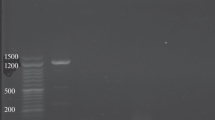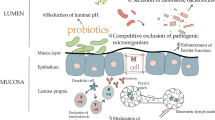Abstract
Transgenic pigs containing sFat-1 (synthesized fatty acid desaturase-1) gene were produced by DNA microinjection. The meat of these pigs contain ω-3 unsaturated fatty acid which is beneficial to the health of human being. The aim of this study is to assess the effects of expression of sFat-1 in pig on the health of animal themselves and on the safety of environment from the angle of the changes in microbe population of pig intestinal tract. Four F1 male semi-sibling of sFat-1 transgenic pigs and four F1 female semi-sibling of sFat-1 transgenic pigs were used as experimental animals, together with their none transgenic siblings as control animals. For inspection of any change in populations of microbial flora in various parts of intestinal tract and feces of sFat-1 transgenic pigs total aerobe, total anaerobe, main beneficial bacteria and main harmful bacteria were cultured and analyzed. At the same time foreign gene drift was assessed by PCR amplifying foreign fragment in samples of total aerobe and total anaerobe. Results indicated that in comparison with control pig microbe population of various species in different parts of intestinal tract and feces of sFat-1 transgenic pig remained unchanged and foreign gene sequence could not be detected in DNA of total aerobe and total anaerobe. In conclusion, the data of this study suggest that microbe population in intestinal tract and feces of transgenic pig was not influenced by the expression of transferred foreign gene sFat-1 and also foreign gene drifting from animal genome to microbial genome must be a rare incident.





Similar content being viewed by others
References
Deppenmeier S, Bock O, Mengel M, Niemann H, Kues W, Lemme E et al (2006) Health status of transgenic pig lines expressing human complement regulator protein CD59. Xenotransplantation 13:345–356
Dierick NA, Decuypere JA, Molly K et al (2002a) The combined use of triacylglycerols containing medium-chain fatty acids (MCFAs) and exogenous lipolytic enzymes as an alternative for nutritional antibiotics in piglet nutrition: I. In vitro screening of the release of MCFAs from selected fat sources by selected exogenous lipolytic enzymes under simulated pig gastric conditions and their effects on the gut flora of piglets. Livest Prod Sci 75:129–142
Dierick NA, Decuypere JA, Molly K et al (2002b) The combined use of triacylglycerols (TAGs) contain-ing medium chain fatty acids (MCFAs) and exogenous lipolytic enzymes as an alternative to nutritional antibiotics in piglet nutrition: II. In vivo release of MCFAs in gastric cannulated and slaughtered piglets by endogenous and exogenous lipases; effect on the luminal gut flora and growth performance. Livest Prod Sci 76:1–16
Hammer RE, Pursel VG, Rexroad CE Jr, Wall RJ, Bolt DJ, Ebert KM et al (1985) Production of transgenic rabbits, sheep and pigs by microinjection. Nature 315:680–683
Isaacs CE, Litov RE, Thormar H (1995) Antimicrobial activity of lipids added to human milk, infant formula, and bovine milk. J Nutr Biochem 6:362–366
Juárez M, Polvillo O, Contò M, Ficco A, Ballico S, Failla S (2008) Comparison of four extraction/methylation analytical methods to measure fatty acid composition by gas chromatography in meat. J Chromatogr A 1190:327–332
Lai L, Kang JX, Li R, Wang J, Witt WT, Yong HY et al (2006) Generation of cloned transgenic pigs rich in omega-3 fatty acids. Nat Biotechnol 24:435–436
Matsumoto K, Kakidani H, Takahashi A, Nakagata N, Anzai M, Matsuzaki Y et al (1993) Growth retardation in rats whose growth hormone gene expression was suppressed by antisense RNA transgene. Mol Reprod Dev 36:53–58
Mitsuoka T et al (1977) The microflora is made from the twelve animals. Am J Clin Nutr 30:1799–1810
Niemann H (2004) Transgenic pigs expressing plant genes. Proc Natl Acad Sci USA 101:7211–7212
Poulsen M, Kroghsbo S, Schrøder M, Wilcks A, Jacobsen H, Miller A et al (2007) A 90-day safety study in Wistar rats fed genetically modified rice expressing snowdrop lectin Galanthus nivalis (GNA). Food Chem Toxicol 45:350–363
Saeki K, Matsumoto K, Kinoshita M, Suzuki I, Tasaka Y, Kano K et al (2004) Functional expression of a Delta12 fatty acid desaturase gene from spinach in transgenic pigs. Proc Natl Acad Sci USA 101:6361–6366
Schrøder M, Poulsen M, Wilcks A, Kroghsbo S, Miller A, Frenzel T et al (2007) A 90-day safety study of genetically modified rice expressing Cry1Ab protein (Bacillus thuringiensis toxin) in Wistar rats. Food Chem Toxicol 45:339–349
Sprong RC, Hulstein MF, Van der Meer R (2001) Bactericidal activities of milk lipids. Antimicrob Agents Chemother 45:1298–1301
Tucker A, Belcher C, Moloo B, Bell J, Mazzulli T, Humar Y et al (2002) The production of transgenic pigs for potential use in clinical xenotransplantation: baseline clinical pathology and organ size studies. Xenotransplantation 9:203–208
Van Reenen CG, Meuwissen THE, Hopster H, Oldenbroek K, Kruip TH, Blokhuis HJ (2001) Transgenesis may affect farm animal welfare: a case for systemic risk assessment. J Anim Sci 79:1763–1769
Wallis JG, Watts JL, Browse J (2002) Polyunsaturated fatty acid synthesis: what will they think of next? Trends Biochem Sci 27:467–473
Yu H, Liao L, Chen P, Chen Z, Liu J, Xie M (2000) Studies on intestinal microflora of weanling piglets. Chinese J Microecol 12:81–82
Acknowledgments
The authors wish especially to thank all the animal technicians in Wuhan experimental farms for help with samples collection and to Prof. Yongfu Chen, Prof. Jian Hou, Prof. Jinzeng Yang for valuable comments and suggestions on the manuscript and to Qingxue Liu, Jun Yang and Linqin Liu for excellent technical assistance. This work was supported by National Transgenic Project of China, National Natural Science Foundation of China, National 863 Project of China and National Key Basic Research Projects of China.
Author information
Authors and Affiliations
Corresponding author
Rights and permissions
About this article
Cite this article
Tang, M., Zheng, X., Cheng, W. et al. Safety assessment of sFat-1 transgenic pigs by detecting their co-habitant microbe in intestinal tract. Transgenic Res 20, 749–758 (2011). https://doi.org/10.1007/s11248-010-9457-7
Received:
Accepted:
Published:
Issue Date:
DOI: https://doi.org/10.1007/s11248-010-9457-7




